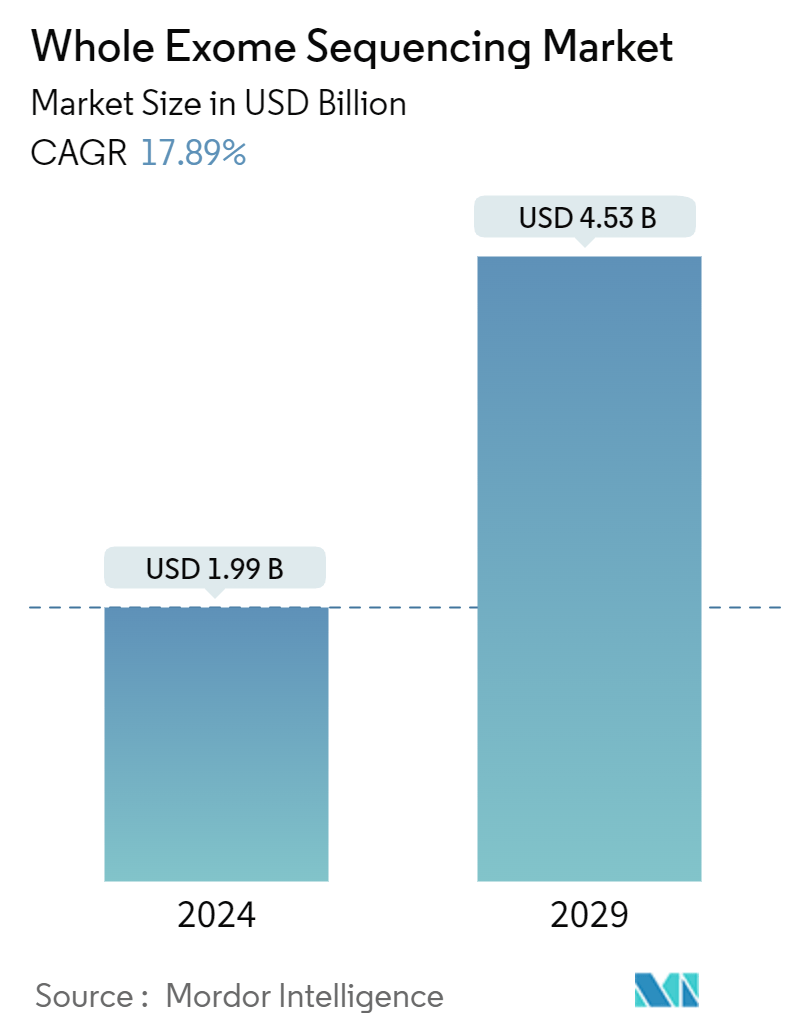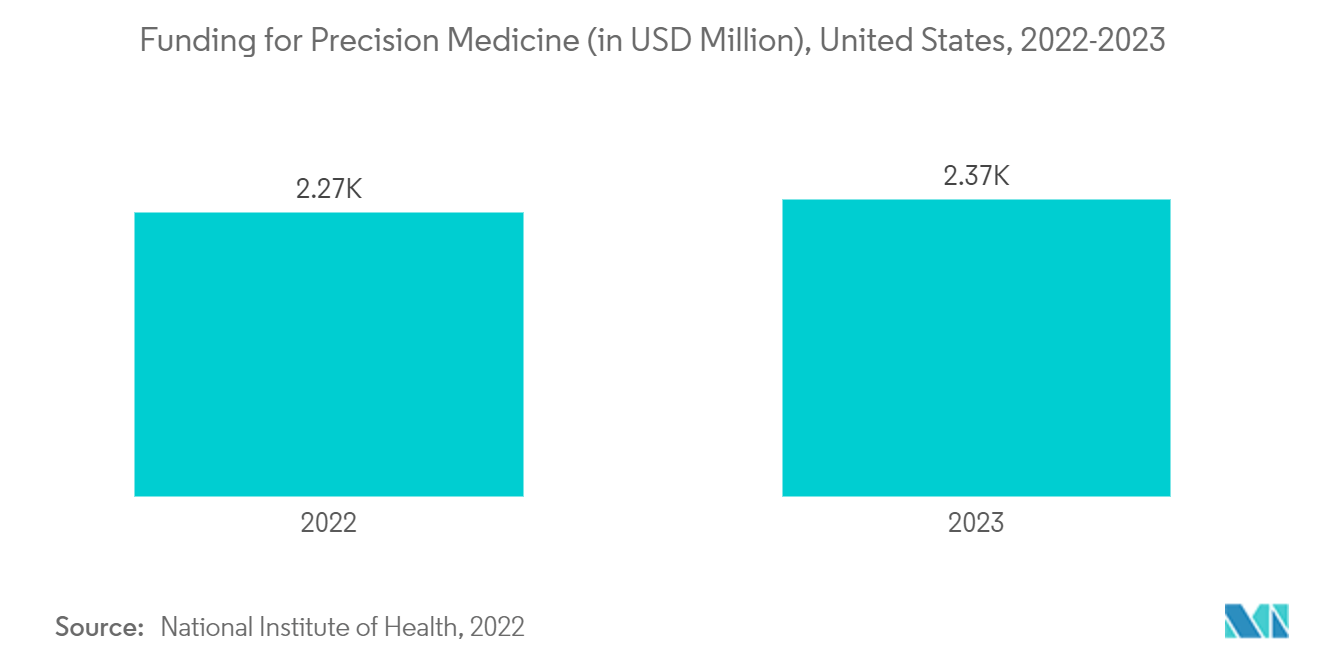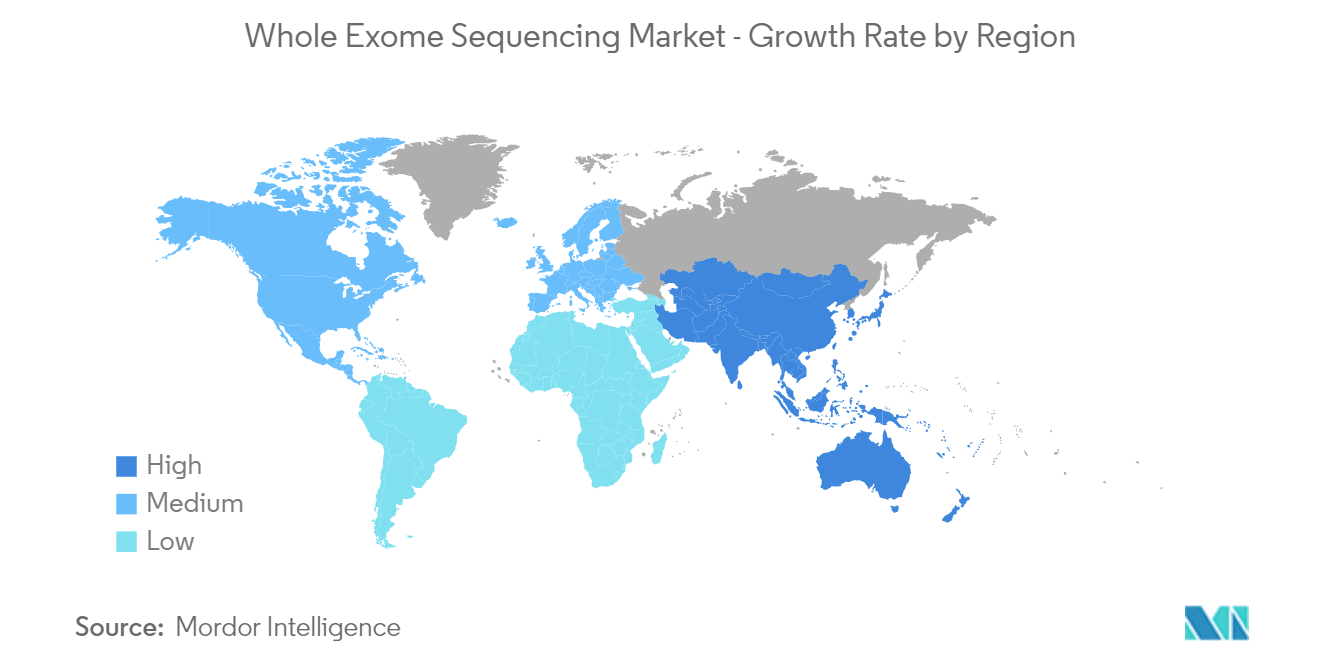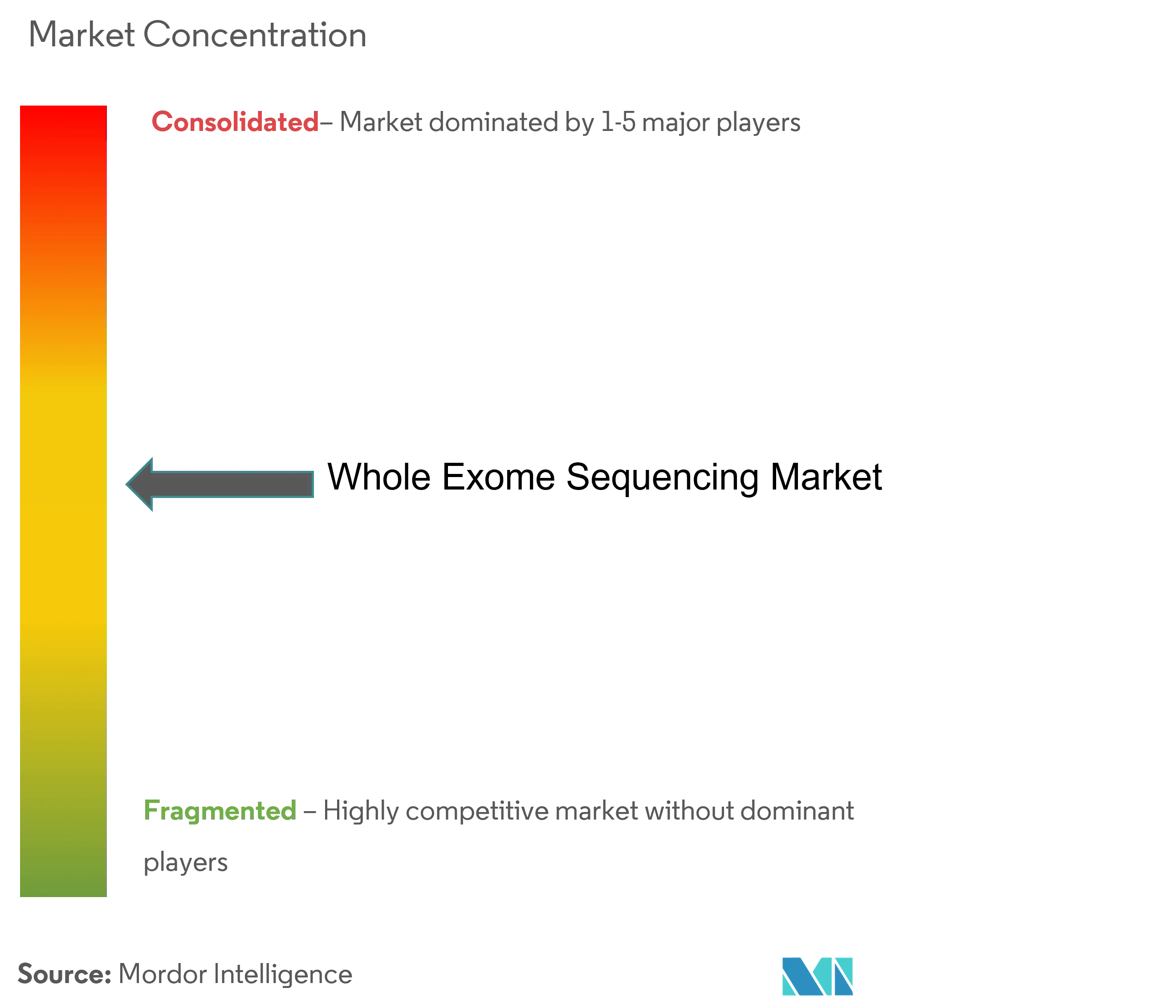Whole Exome Sequencing Market Size

| Study Period | 2019 - 2029 |
| Market Size (2024) | USD 1.99 Billion |
| Market Size (2029) | USD 4.53 Billion |
| CAGR (2024 - 2029) | 17.89 % |
| Fastest Growing Market | Asia-Pacific |
| Largest Market | North America |
Major Players
*Disclaimer: Major Players sorted in no particular order |
Whole Exome Sequencing Market Analysis
The Whole Exome Sequencing Market size is estimated at USD 1.99 billion in 2024, and is expected to reach USD 4.53 billion by 2029, growing at a CAGR of 17.89% during the forecast period (2024-2029).
Key factors propelling the global whole exome sequencing market include its rising applications in clinical diagnostics, heightened demand for rare disease diagnoses, intensified R&D efforts in genomics and next-generation sequencing, and an increasing appetite for personalized medicine. For example, a March 2022 article in the British Medical Journal highlighted that whole exome sequencing is routinely available for a select group of patients diagnosed with rare childhood genetic diseases. The article further emphasized that next-generation sequencing can rapidly sequence hundreds or even thousands of genes at a significantly reduced cost. Given these advantages, the market for whole exome sequencing is poised for growth in the coming years.
Additionally, whole exome sequencing plays a pivotal role in testing the genomes of viruses linked to diseases like HIV, cancer, and COVID-19. As the prevalence of these diseases rises, so does the demand for whole-exome sequencing. For instance, according to the World Health Organization (WHO) HIV Statistics, around 39.9 million people globally were living with HIV in 2023. Such genomic sequencing methods shed light on genetic variants that may lead to diseases, further amplifying the demand for RNA sequencing.
Moreover, the surge in R&D within genomics and next-generation sequencing is fueling market growth. For instance, in May 2022, NanoString Technologies Inc. unveiled a cloud-based workflow designed to enhance spatial data analysis for users of the Illumina NextSeq 1000, NextSeq 2000 sequencing systems, and the GeoMx Digital Spatial Profiler. This innovation streamlines the spatial analysis of whole transcriptomes in tandem with proteome analytes due to its integrated, user-friendly run planning tool. Such advancements are expected to bolster the market further.
In conclusion, the aforementioned factors indicate a robust growth trajectory for the market. The intricate nature of the technique, a pressing need for skilled professionals, and the legal and ethical dilemmas surrounding whole exome sequencing may restrain the market's expansion.
Whole Exome Sequencing Market Trends
Personalized Medicine Segment is Expected to Witness Significant Growth Over the Forecast Period
Personalized medicine tailors therapies to individual patients based on the molecular underpinnings of their diseases. This approach has gained traction in recent years. Often referred to as "individualized medicine," precision medicine diverges from traditional methods by emphasizing each patient's distinct genetic profile. With advancements in genetics and a deeper comprehension of human genetic makeup, especially how it influences health, development, and drug responses, medical professionals are crafting safer, more effective treatments for a myriad of health conditions. The benefits of precision medicine are manifold, enhancing both health and healthcare.
Factors propelling the personalized medicine segment include the rising prevalence of various cancers, the affordability of personalized therapies for cancer and other diseases, reduced side effects from tailored treatments, widespread adoption in developed markets, and the emergence of innovative drugs.
For example, in August 2022, the Medical Device Innovation Consortium initiated a pilot project under its Somatic Reference Sample (SRS) Initiative. This project aims to refine the validation and regulatory review processes for cancer diagnostics utilizing next-generation sequencing (NGS). NGS stands out as a transformative technology, unlocking new avenues in diagnostics and therapeutics. However, for these diagnostic tests to be clinically viable, they must undergo rigorous validation, a process heavily reliant on reference samples.
Furthermore, market players are engaging in strategic maneuvers like partnerships, mergers, acquisitions, and product launches, all of which are expected to fuel the segment's expansion. For instance, in November 2023, Illumina unveiled its Global Health Access Initiative, targeting pathogen sequencing in low- and middle-income countries. This initiative offers discounted rates on a range of sequencing applications. These include drug resistance profiling for tuberculosis, whole-genome sequencing to monitor evolving and reemerging viruses, respiratory pathogen detection for influenza-like illness surveillance, environmental monitoring (like wastewater analysis) to track pathogens, and overseeing population-level antimicrobial resistance.
Given these dynamics, the personalized medicine segment is poised for substantial growth in the coming years.

North America is Expected to Witness a Significant Growth Over the Forecast Period
North America stands out as a leading regional market in terms of revenue. Key drivers fueling the growth of the whole-exome sequencing market include the rising prevalence of genetic and chronic disorders like cancer, an aging population, an increasing demand for targeted and personalized medicine, and supportive government initiatives. As reported by HIV.gov in October 2022, approximately 1.2 million individuals in the United States were affected by HIV. This underscores a rising burden of infectious diseases, which is expected to register a heightened demand for diagnostics and bolster market growth during the forecast period.
Mergers, acquisitions, product launches, and partnerships among key players further energize market dynamics in the region. A notable example is QIAGEN's exclusive strategic partnership with California-based Helix, a population genomics leader established in January 2023. This collaboration is set to advance the development of companion diagnostics for hereditary diseases. The integrated services, powered by advanced NGS and PCR technologies, promise rapid patient recruitment, real-world evidence, and comprehensive diagnostic solutions.
Given these dynamics, including the rising prevalence of infectious diseases and active product launches, the North American market is poised for substantial growth in the coming years.

Whole Exome Sequencing Industry Overview
The whole exome sequencing market is moderately consolidated in nature due to the presence of a few companies operating globally as well as regionally. The competitive landscape includes an analysis of some international and domestic companies that hold market shares and are well known, including Eurofins Scientific Group, Bio-Rad Laboratories Inc., F. Hoffmann-La Roche AG, illumine Inc., and Thermo Fisher Scientific Inc. Konica Minolta Inc. (Ambry Genetics), Beijing Genomics Institute, Azenta Inc., Psomagen Inc. (Macrogen Inc.), PerkinElmer Inc., GENEYX GENOMEX, and CD Genomics, QIAGEN Inc.
Whole Exome Sequencing Market Leaders
-
Bio-Rad Laboratories Inc.
-
Eurofins Scientific Group
-
F. Hoffmann-La Roche AG
-
Illumina Inc.
-
Thermo Fisher Scientific Inc.
*Disclaimer: Major Players sorted in no particular order

Whole Exome Sequencing Market News
- May 2024: SOPHiA GENETICS, a prominent player in data-driven medicine, partnered with tech giants Microsoft and NVIDIA to revolutionize healthcare by introducing an advanced, scalable whole genome sequencing (WGS) analytical solution. The trio aims to roll out this cutting-edge solution to healthcare providers by the year's end.
- February 2023: Illumina Inc. reported that its first NovaSeqX Plus system was delivered to the Broad Institute. The platform will support groups wanting to access the sequencing service, the company's human whole genome product, and blended genome/exome product.
Whole Exome Sequencing Market Report - Table of Contents
1. INTRODUCTION
- 1.1 Study Assumption and Market Definition
- 1.2 Scope of the Study
2. RESEARCH METHODOLOGY
3. EXECUTIVE SUMMARY
4. MARKET DYNAMICS
- 4.1 Market Overview
-
4.2 Market Drivers
- 4.2.1 Increasing Applications in the Clinical Diagnosis and Growing Demand for the Diagnosis of Rare Diseases
- 4.2.2 Increasing R&D in the Field of Genomics and Next-generation Sequencing
- 4.2.3 Increasing Demand for Personalized Medicine
-
4.3 Market Restraints
- 4.3.1 High Complexity of Technique and Lack of Skilled Personnel
- 4.3.2 Legal and Ethical Issues Associated with Whole Exome Sequencing
-
4.4 Porter's Five Forces Analysis
- 4.4.1 Threat of New Entrants
- 4.4.2 Bargaining Power of Buyers/Consumers
- 4.4.3 Bargaining Power of Suppliers
- 4.4.4 Threat of Substitute Products
- 4.4.5 Intensity of Competitive Rivalry
5. MARKET SEGMENTATION (Market Size by Value in USD)
-
5.1 By Product Type
- 5.1.1 System
- 5.1.2 Kits
- 5.1.3 Services
-
5.2 By Technology
- 5.2.1 Second-Generation Sequencing
- 5.2.1.1 Sequencing by Synthesis (SBS)
- 5.2.1.2 Sequencing by Hybridization and Ligation (SBL)
- 5.2.2 Third-generation Sequencing
-
5.3 By Application
- 5.3.1 Diagnostics
- 5.3.2 Drug Discovery and Development
- 5.3.3 Personalized Medicine
- 5.3.4 Other Applications (Agriculture, Animal Research, etc.)
-
5.4 By Geography
- 5.4.1 North America
- 5.4.1.1 United States
- 5.4.1.2 Canada
- 5.4.1.3 Mexico
- 5.4.2 Europe
- 5.4.2.1 Germany
- 5.4.2.2 United Kingdom
- 5.4.2.3 France
- 5.4.2.4 Italy
- 5.4.2.5 Spain
- 5.4.2.6 Rest of Europe
- 5.4.3 Asia-Pacific
- 5.4.3.1 China
- 5.4.3.2 Japan
- 5.4.3.3 India
- 5.4.3.4 Australia
- 5.4.3.5 South Korea
- 5.4.3.6 Rest of Asia-Pacific
- 5.4.4 Middle East and Africa
- 5.4.4.1 GCC
- 5.4.4.2 South Africa
- 5.4.4.3 Rest of Middle East and Africa
- 5.4.5 South America
- 5.4.5.1 Brazil
- 5.4.5.2 Argentina
- 5.4.5.3 Rest of South America
6. COMPETITIVE LANDSCAPE
-
6.1 Company Profiles
- 6.1.1 Konica Minolta Inc. (Ambry Genetics)
- 6.1.2 Beijing Genomics Institute
- 6.1.3 Bio-Rad Laboratories Inc.
- 6.1.4 Eurofins Scientific Group
- 6.1.5 F. Hoffmann-La Roche AG
- 6.1.6 Azenta, Inc.
- 6.1.7 Illumina Inc.
- 6.1.8 Psomagen Inc. (Macrogen Inc.)
- 6.1.9 PerkinElmer Inc.
- 6.1.10 Thermo Fisher Scientific Inc.
- 6.1.11 GENEYX GENOMEX
- 6.1.12 CD Genomics
- 6.1.13 QIAGEN Inc.
- *List Not Exhaustive
7. MARKET OPPORTUNITIES AND FUTURE TRENDS
** Subject To AvailablityWhole Exome Sequencing Industry Segmentation
As per the scope of the report, exome sequencing is a technique for sequencing all the exome and protein-coding genes in a genome. This technique includes the selection of the subset of DNA that encodes proteins or exons, followed by sequencing of the exonic DNA using high-throughput DNA sequencing methods. It also provides a cost-effective screening approach for the diagnosis of genetic disorders. It presents itself as a less resource-intensive alternative to whole-genome sequencing in several applications, including drug discovery and development processes.
The whole exome sequencing market is segmented by product type, technology, application, and geography. By product type, the market is segmented into systems, kits, and services. By technology, the market is segmented into second-generation sequencing and third-generation sequencing. By second-generation sequencing, the market is segmented into sequencing, by synthesis (SBS) and sequencing, by hybridization and ligation (SBL). By application, the market is segmented into diagnostics, drug discovery and development, personalized medicine, and other applications. By geography, the market is segmented into North America, Europe, Asia-Pacific, the Middle East and Africa, and South America. The report offers the value (USD) for the above segments.
| By Product Type | System | |
| Kits | ||
| Services | ||
| By Technology | Second-Generation Sequencing | Sequencing by Synthesis (SBS) |
| Sequencing by Hybridization and Ligation (SBL) | ||
| By Technology | Third-generation Sequencing | |
| By Application | Diagnostics | |
| Drug Discovery and Development | ||
| Personalized Medicine | ||
| Other Applications (Agriculture, Animal Research, etc.) | ||
| By Geography | North America | United States |
| Canada | ||
| Mexico | ||
| By Geography | Europe | Germany |
| United Kingdom | ||
| France | ||
| Italy | ||
| Spain | ||
| Rest of Europe | ||
| By Geography | Asia-Pacific | China |
| Japan | ||
| India | ||
| Australia | ||
| South Korea | ||
| Rest of Asia-Pacific | ||
| By Geography | Middle East and Africa | GCC |
| South Africa | ||
| Rest of Middle East and Africa | ||
| By Geography | South America | Brazil |
| Argentina | ||
| Rest of South America |
Whole Exome Sequencing Market Research FAQs
How big is the Whole Exome Sequencing Market?
The Whole Exome Sequencing Market size is expected to reach USD 1.99 billion in 2024 and grow at a CAGR of 17.89% to reach USD 4.53 billion by 2029.
What is the current Whole Exome Sequencing Market size?
In 2024, the Whole Exome Sequencing Market size is expected to reach USD 1.99 billion.
Who are the key players in Whole Exome Sequencing Market?
Bio-Rad Laboratories Inc., Eurofins Scientific Group, F. Hoffmann-La Roche AG, Illumina Inc. and Thermo Fisher Scientific Inc. are the major companies operating in the Whole Exome Sequencing Market.
Which is the fastest growing region in Whole Exome Sequencing Market?
Asia-Pacific is estimated to grow at the highest CAGR over the forecast period (2024-2029).
Which region has the biggest share in Whole Exome Sequencing Market?
In 2024, the North America accounts for the largest market share in Whole Exome Sequencing Market.
What years does this Whole Exome Sequencing Market cover, and what was the market size in 2023?
In 2023, the Whole Exome Sequencing Market size was estimated at USD 1.63 billion. The report covers the Whole Exome Sequencing Market historical market size for years: 2019, 2020, 2021, 2022 and 2023. The report also forecasts the Whole Exome Sequencing Market size for years: 2024, 2025, 2026, 2027, 2028 and 2029.
Whole Exome Sequencing Industry Report
Statistics for the 2024 Whole Exome Sequencing market share, size and revenue growth rate, created by Mordor Intelligence™ Industry Reports. Whole Exome Sequencing analysis includes a market forecast outlook to 2029 and historical overview. Get a sample of this industry analysis as a free report PDF download.



